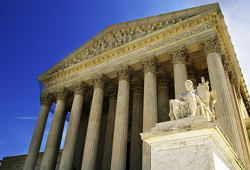 On November 13, 2018, the Supreme Court granted certiorari in PDR Network, LLC v. Carlton & Harris Chiropractic (No. 17-1705), to answer the question whether the Hobbs Act required the district court to accept the Federal Communication Commission’s (FCC’s) legal interpretation of the Telephone Consumer Protection Act (TCPA). At issue are two competing doctrines, which are the subject of a circuit split, and which the Supreme Court is now expected to clarify. Applying Chevron USA, Inc. v. Nat. Res. Def. Council, Inc. (467 U.S. 837 (1984)), some circuits have held that a district court may review an unambiguous statute on its face, and is not required to defer to (or even consider) administrative regulatory guidance interpreting the same statute. By contrast, the Hobbs Act (28 U.S.C. § 2342), grants Courts of Appeals exclusive jurisdiction to review final orders of the FCC (as well as rulemaking from certain specified other agencies). The question before the Supreme Court is whether, by vesting circuit courts with original jurisdiction to review agency rulemaking, Congress also intended to require district courts to follow agency rulemaking that is relevant to the statute under review.
On November 13, 2018, the Supreme Court granted certiorari in PDR Network, LLC v. Carlton & Harris Chiropractic (No. 17-1705), to answer the question whether the Hobbs Act required the district court to accept the Federal Communication Commission’s (FCC’s) legal interpretation of the Telephone Consumer Protection Act (TCPA). At issue are two competing doctrines, which are the subject of a circuit split, and which the Supreme Court is now expected to clarify. Applying Chevron USA, Inc. v. Nat. Res. Def. Council, Inc. (467 U.S. 837 (1984)), some circuits have held that a district court may review an unambiguous statute on its face, and is not required to defer to (or even consider) administrative regulatory guidance interpreting the same statute. By contrast, the Hobbs Act (28 U.S.C. § 2342), grants Courts of Appeals exclusive jurisdiction to review final orders of the FCC (as well as rulemaking from certain specified other agencies). The question before the Supreme Court is whether, by vesting circuit courts with original jurisdiction to review agency rulemaking, Congress also intended to require district courts to follow agency rulemaking that is relevant to the statute under review.
The case concerns an unsolicited fax the defendant allegedly sent to the plaintiff containing an offer for a free ebook. The question before the district court was whether the fax constituted a prohibited unsolicited “advertisement” under the TCPA. See 47 U.S.C. § 227(b)(1)(C). The TCPA defines an unsolicited advertisement as “any material advertising the commercial availability or quality of, goods, or services which is transmitted to any person without that person’s express invitation or permission, in writing or otherwise.” 47 U.S.C. § 227(a)(5). Citing a 2006 FCC Rule—which provides that “facsimile messages that promote goods or services even at no cost . . . are unsolicited advertisements under the TCPA’s definition”—the plaintiff contended that the challenged fax constituted an “advertisement” within the meaning of the rule. See In re Rules and Regulations Implementing the Telephone Consumer Protection Act of 1991: Junk Fax Prevention Act of 2005, 71 FR 25967, 25973 (May 3, 2006) (FCC Junk Fax Rule). The plaintiff further argued that, under the Hobbs Act, the district court was required to follow the FCC’s rule as a binding interpretation of the TCPA.
The district court disagreed, however, finding that the Hobbs Act does not require district courts to follow FCC interpretations of the rule; rather, the Hobbs Act vests exclusive jurisdiction in the circuit courts to review the validity of FCC final orders. Given that the plaintiff did not challenge the validity of the FCC’s order, the court reasoned that the Hobbs Act did not apply and, under Chevron, the court was permitted to interpret the TCPA independently. And, after consulting cases and dictionaries interpreting the meaning of the term “advertisement,” the district court held that the TCPA is unambiguous, and concluded that a fax must have a “commercial aim” to constitute a prohibited unsolicited advertisement under the TCPA. The court then dismissed the case, finding that the challenged fax did not have the requisite “commercial aim” because it did nothing more than offer a free ebook.
The Fourth Circuit reversed, holding that the Hobbs Act required the district court to defer to the FCC’s interpretation of the TCPA in its final rule. The Fourth Circuit reasoned that Congress intended to strip jurisdiction from district courts to determine the validity of any final FCC rule when it enacted the Hobbs Act, and that the district court was therefore bound to follow the FCC’s interpretation of the TCPA as encompassing even advertisements for “free” goods and services as within the scope of a prohibited “unsolicited advertisement.”
In deciding that the Hobbs Act precludes the district court from engaging in a Chevron analysis, the Fourth Circuit created a split with the Second and Sixth Circuits, both of which permit district courts to engage in a Chevron analysis in like circumstances. See Physicians Healthsource, Inc. v. Boehringer Ingelheim Pharm., Inc., 847 F.3d 92 (2d Cir. 2017); Sandusky Wellness Ctr., LLC v. Medco Health Sols., Inc., 788 F.3d 218, 223-24 (6th Cir. 2015). The Supreme Court is now poised to resolve that split. LenderLaw Watch will bring you a detailed analysis of that decision as soon as it becomes available.

